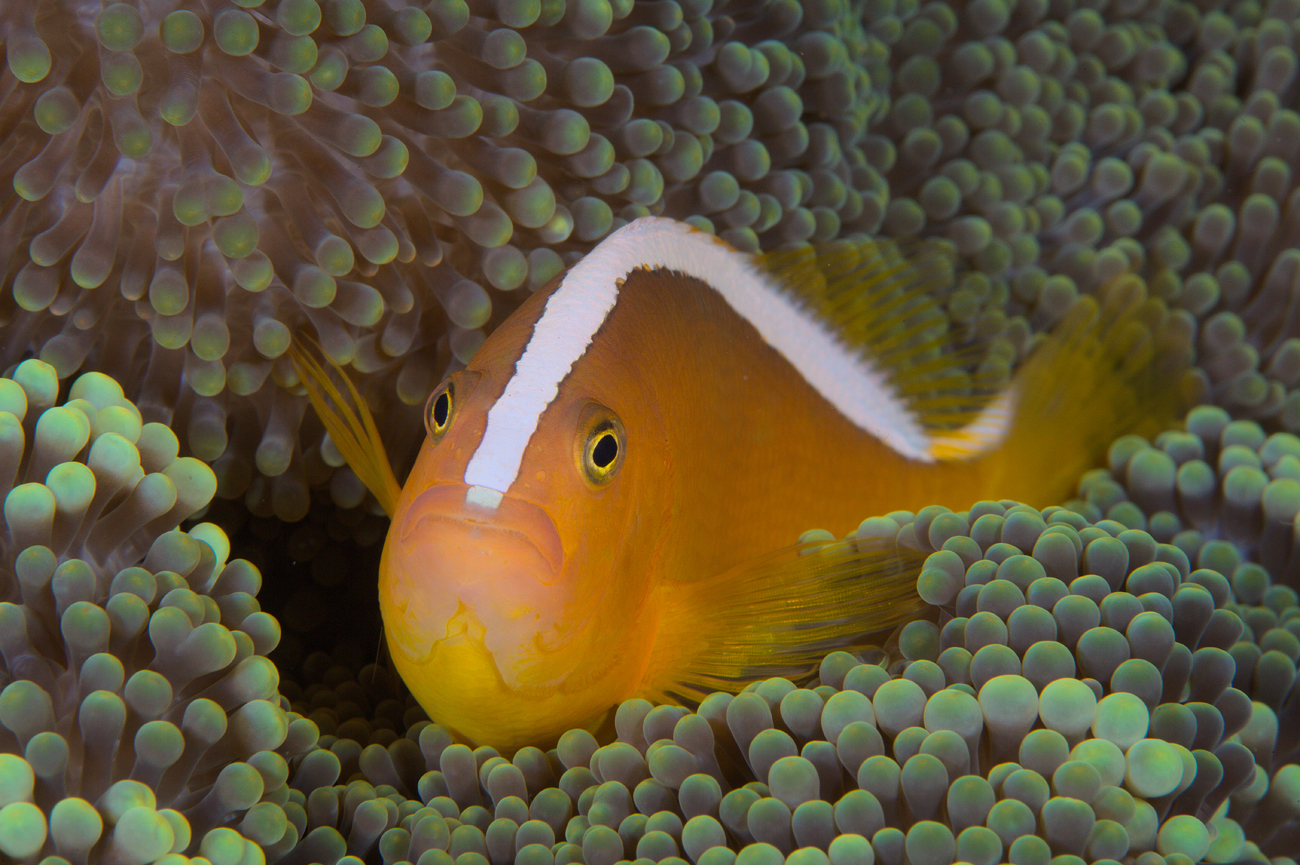- Classification
- ACTINOPTERYGII
- PERCIFORMES
- POMACENTRIDAE
- Amphiprion
- sandaracinos
Orange Anemonefish, Amphiprion sandaracinos Allen 1972

An Orange Anemonefish, Amphiprion sandaracinos, at Moalboal, Basdiot, Central Visayas, Philippines. Source: Klaus Stiefel / Flickr. License: CC BY Attribution-Noncommercial
Video of Orange Anemonefish in an aquarium.
Orange Anemonefish, Amphiprion sandaracinos Allen 1972
More Info
|
Distribution |
Known from Western Australia (Ningaloo Reef and WA offshore reefs, Ashmore Reef, Timor Sea, and the Christmas Island in the eastern Indian Ocean. Elsewhere, the Orange Anemonefish occurs in the tropical East-Indo-West Pacific, from Papua New Guinea, Indonesia, Melanesia, the Philippines and north to southern Japan. The Orange Anemonefish inhabits coral reef lagoons and outer reefs in depths of 3-20 m. The species usually lives in association with the host anemone Stichodactyla mertensii, although it is also found with Heteractis crispa. An adult pair and several juveniles usually live in association with a single anemone. |
|
Biology |
Anemonefish are protandrous hermaphrodites, and individuals are capable of changing sex from male to female. Orange Anemonefish live in small groups with a dominant pair and a number of juveniles. The dominant female lays her eggs in a nest area prepared by the dominant male. He guards and aerates the eggs until the larvae hatch. |
|
Fisheries |
Orange anemonefish, along with their host anemones are collected for the aquarium trade, and the anemonefish has been bred in captivity. The species is also threatened in parts of its range by habitat degradation. |
|
Similar Species |
The Pink Anemonefish, Amphiprion perideraion, differs in having a narrow white band on the side of the head behind the eye. The paler Amphiprion akallopisos (not found in the Australian EEZ) is very similar, but the stripe along the back is narrower, and does not begin on the upper lip. |
|
Species Citation |
Amphiprion sandaracinos Allen 1972, Anemonefishes, their Classification and Biology: 81. Type locality: Pagbilao Island, Luzon, Philippines. |
|
Author |
Bray, D.J. 2016 |
|
Resources |
Orange Anemonefish, Amphiprion sandaracinos Allen 1972
References
Allen, G.R. 1972. Anemonefishes, their Classification and Biology. Neptune CityNew Jersey : T.F.H. Publications 288 pp., 140 figs.
Allen, G.R. 2001. Family Pomacentridae. pp. in Carpenter, K.E. & Niem, T.H. (eds) The Living Marine Resources of the Western Central Pacific. FAO Species Identification Guide for Fisheries Purposes. Rome : FAO Vol. 6 pp. 3381-4218.
Allen, G.R., Drew, J. & Fenner, D. 2010. Amphiprion pacificus, a new species of anemonefish (Pomacentridae) from Fiji, Tonga, Samoa, and Wallis Island. Aqua, International Journal of Ichthyology 16(3): 129-138.Allen, G.R. & Erdmann, M.V. 2012. Reef fishes of the East Indies. Perth : Tropical Reef Research 3 vols, 1260 pp.
Allen, G.R. & Steene, R.C. 1979. The Fishes of Christmas Island, Indian Ocean. Aust. Natl. Parks Wldlf. Ser. Spec. Publ. 2. Canberra : Australian Government Publishing Service 81 pp. 15 pls.
Allen, G.R., Steene, R.C. & Orchard, M. Fishes of Christmas Island. Christmas Island : Christmas Island Natural History Association 2 edn, 284 pp.
Allen, G.R., Steene, R.C.& Orchard, M. 2007. Fishes of Christmas Island. Christmas Island : Christmas Island Natural History Association 2, 284 pp.
Bos, A.R. 2011. Clownfishes Amphiprion clarkii and A. sandaracinos (Pomacentridae) coexist in the sea anemone Stichodactyla mertensii. Coral Reefs 30(2): 369.
Fautin, D.G. & Allen, G.R. 1992. Field guide to anemonefishes and their host sea anemones. Western Australian Museum, Perth.
Kuiter, R.H. 1992. Tropical Reef-Fishes of the Western Pacific, Indonesia and Adjacent Waters. Jakarta : PT Gramedia Pustaka Utama 314 pp. pls.
Moyer, J.T. & Nakazono, A. 1978. Protandrous hermaphroditism in six species of the anemonefish genus Amphiprion in Japan. Japanese Journal of Ichthyology 25(2): 101-106.
Myers, R.F. 1999. Micronesian reef fishes: a comprehensive guide to the coral reef fishes of Micronesia. Coral Graphics, Barrigada, Guam.







